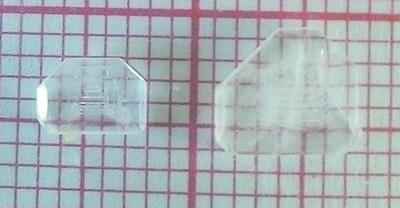当前位置:
X-MOL 学术
›
J. Appl. Crystallogr.
›
论文详情
Our official English website, www.x-mol.net, welcomes your feedback! (Note: you will need to create a separate account there.)
Effect of 2,4-dinitrophenol dye doping on tristhioureazinc(II) sulfate single crystals: a potential nonlinear optical material
Journal of Applied Crystallography ( IF 6.1 ) Pub Date : 2020-07-08 , DOI: 10.1107/s1600576720006585 G. Durgababu , G. J. Nagaraju , G. Bhagavannarayana
Journal of Applied Crystallography ( IF 6.1 ) Pub Date : 2020-07-08 , DOI: 10.1107/s1600576720006585 G. Durgababu , G. J. Nagaraju , G. Bhagavannarayana

|
Good quality single crystals of 2,4-dinitrophenol (DNP)-doped tristhioureazinc(II) sulfate (ZTS) were successfully grown by employing the simple and cost effective slow-evaporation solution technique. To study the effect of doping on various device properties, the grown single crystals were subjected to powder X-ray diffraction (PXRD), high-resolution XRD, thermogravimetric analysis (TGA), Vickers hardness testing, and UV–visible, photoluminescence (PL) and Fourier transform IR (FTIR) spectroscopy techniques. The crystal structure of DNP-doped ZTS bulk single crystals remained the same as the crystal structure of ZTS. However, the changes in intensities of the diffraction peaks in the PXRD spectra indicated the incorporation of dopants into the crystalline matrix. FTIR studies confirm the incorporation of dopants into the crystalline matrix, shown by the shifting of certain prominent absorption bands towards higher energy. This also indicated the induced useful strain due to doping, leading to charge transfer and the enhancement of nonlinear optical properties. The cut-off wavelength and optical band gap energy of pure ZTS and DNP-doped ZTS crystals were studied by UV–visible absorption spectroscopy, revealing a slight reduction in the optical band gap energy due to doping, which in turn revealed the enhancement of the optical range. PL studies revealed an enhanced optical range of photoluminescence in ZTS crystals. Second harmonic generation (SGH) studies carried out by the Kurtz powder technique revealed the enhancement of SHG value due to DNP doping. To ensure the thermal stability and mechanical strength of the grown crystals with doping (required from the point of view of device applications), TGA and Vicker's hardness studies were performed.
中文翻译:

2,4-二硝基苯酚染料掺杂对三硫脲嗪(II)硫酸盐单晶的影响:一种潜在的非线性光学材料
通过采用简单且具有成本效益的慢蒸发溶液技术,成功生长了 2,4-二硝基苯酚 (DNP) 掺杂的三硫脲嗪 (II) 硫酸盐 (ZTS) 的优质单晶。为了研究掺杂对各种器件性能的影响,对生长的单晶进行粉末 X 射线衍射 (PXRD)、高分辨率 XRD、热重分析 (TGA)、维氏硬度测试和紫外可见光、光致发光 (PL ) 和傅里叶变换红外 (FTIR) 光谱技术。DNP 掺杂的 ZTS 块状单晶的晶体结构与 ZTS 的晶体结构保持相同。然而,PXRD 光谱中衍射峰强度的变化表明掺杂剂掺入到晶体基质中。FTIR 研究证实了掺杂剂掺入到晶体基质中,通过某些显着的吸收带向更高能量的转移而表现出来。这也表明由于掺杂引起的有用应变,导致电荷转移和非线性光学特性的增强。通过紫外-可见吸收光谱研究了纯 ZTS 和 DNP 掺杂的 ZTS 晶体的截止波长和光学带隙能量,揭示由于掺杂导致光学带隙能量略有降低,这反过来又揭示了增强光学范围。PL 研究揭示了 ZTS 晶体中光致发光的光学范围增强。由库尔兹粉末技术进行的二次谐波生成 (SGH) 研究表明,由于 DNP 掺杂,SHG 值提高。
更新日期:2020-07-08
中文翻译:

2,4-二硝基苯酚染料掺杂对三硫脲嗪(II)硫酸盐单晶的影响:一种潜在的非线性光学材料
通过采用简单且具有成本效益的慢蒸发溶液技术,成功生长了 2,4-二硝基苯酚 (DNP) 掺杂的三硫脲嗪 (II) 硫酸盐 (ZTS) 的优质单晶。为了研究掺杂对各种器件性能的影响,对生长的单晶进行粉末 X 射线衍射 (PXRD)、高分辨率 XRD、热重分析 (TGA)、维氏硬度测试和紫外可见光、光致发光 (PL ) 和傅里叶变换红外 (FTIR) 光谱技术。DNP 掺杂的 ZTS 块状单晶的晶体结构与 ZTS 的晶体结构保持相同。然而,PXRD 光谱中衍射峰强度的变化表明掺杂剂掺入到晶体基质中。FTIR 研究证实了掺杂剂掺入到晶体基质中,通过某些显着的吸收带向更高能量的转移而表现出来。这也表明由于掺杂引起的有用应变,导致电荷转移和非线性光学特性的增强。通过紫外-可见吸收光谱研究了纯 ZTS 和 DNP 掺杂的 ZTS 晶体的截止波长和光学带隙能量,揭示由于掺杂导致光学带隙能量略有降低,这反过来又揭示了增强光学范围。PL 研究揭示了 ZTS 晶体中光致发光的光学范围增强。由库尔兹粉末技术进行的二次谐波生成 (SGH) 研究表明,由于 DNP 掺杂,SHG 值提高。


























 京公网安备 11010802027423号
京公网安备 11010802027423号